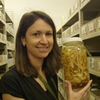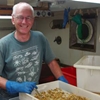General Description
Left claw (cheliped) much larger than right. Claws (chelipeds) and first and second walking legs (pereopods 2 and 3) with outer faces ornamented with transverse striae fringed with short setae. Red and white rings around eyes, red and white stripes on carapace and legs. Claws with blue-purple stripes. Up to 14 cm total length.
Biology
Hermit crabs are scavengers on dead shells and fishes but may be able to catch and feed on crabs and other living animals. They can find food using chemical stimuli. The antennae have "smell detectors" which detect chemicals that stimulate food searching behaviour. When similar detectors on the legs contact food the claws quickly grasp it and pass it into the mouth.
Habitat
Low intertidal, to depths of 200 m.
Reefs
Soft substrates
Distribution guide
Mediterranean and Red Seas, Indo-West Pacific including Japan and New Zealand, and Australia.
Species Group
Depth
Shore (0-1 m)
Shallow (1-30 m)
Deep ( > 30 m)
Water Column
Max Size
14 cm
Diet
Organic matter
Commercial Species
No
Global Dispersal
Recorded in Australia
Species Code
MoV 1709
Conservation Status
- DSE Advisory List : Not listed
- EPBC Act 1999 : Not listed
- IUCN Red List : Not listed







